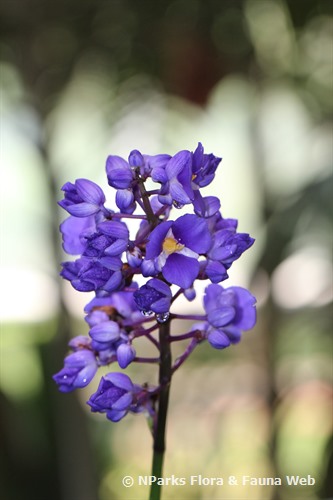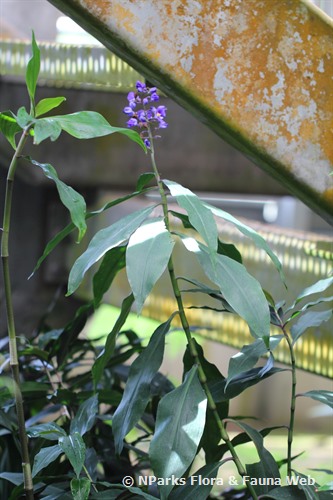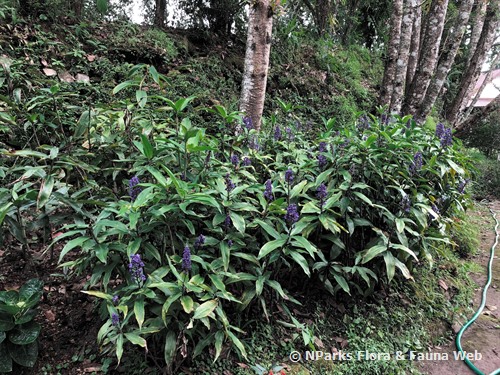
Back
Dichorisandra thyrsiflora
| Family Name: | Commelinaceae |
| Common Name: | Blue Ginger, Blue-flowered Bamboo, Brazilian Ginger |
Name
Classifications and Characteristics
| Plant Growth Form | Shrub |
|---|
Biogeography
| Native Distribution | Brazil |
|---|---|
| Native Habitat | Terrestrial |
| Preferred Climate Zone | Tropical |
| Local Conservation Status | Non-native (Horticultural / Cultivated Only) |
Description and Ethnobotany
| Growth Form | Herbaceous plant growing up to 1-2 m tall. |
|---|---|
| Foliage | Smooth, green leaves are oblong with entire leaf margin. In shady conditions, the midrib becomes purplish red and silver markings develop on both sides of the midrib, running parallel to it. |
| Flowers | Flowers are composed of 3 light blue sepals, 3 bright blue, triangular petals and 6 yellow stamens. They are arranged in a spike-like inflorescence known as a thryse. |
| Cultivation | This species should be protected from direct afternoon sun. It grows best in a location where it receives only morning sun. |
| Etymology | This species is commonly known as 'Blue Ginger', but it is not a true ginger. However, the leaves and growth habit are similar to spiral gingers. |
Landscaping Features
| Desirable Plant Features | Ornamental Flowers |
|---|---|
| Landscape Uses | Skyrise / Balcony, Container Planting |
Plant Care and Propagation
| Light Preference | Semi-Shade |
|---|---|
| Water Preference | Lots of Water |
| Pest(s) | Chewing Insects, Sucking Insects |
| Propagation Method | Seed, Stem Cutting (Herbaceous), Division |
Foliar
| Mature Foliage Colour(s) | Green |
|---|---|
| Leaf Area Index (LAI) for Green Plot Ratio | 3.5 (Shrub & Groundcover - Monocot) |
Floral (Angiosperm)
| Flower & Plant Sexuality | Bisexual Flowers |
| Flower Colour(s) | Purple, Blue |
|---|---|
| Flower Grouping | Cluster / Inflorescence |
| Individual Flower Shape | Campaulate / Bell-shaped |
| Inflorescence Type | Thryse |
| Flowering Habit | Polycarpic |
Image Repository
Others
| Master ID | 637 |
|---|---|
| Species ID | 1932 |
| Flora Disclaimer | The information in this website has been compiled from reliable sources, such as reference works on medicinal plants. It is not a substitute for medical advice or treatment and NParks does not purport to provide any medical advice. Readers should always consult his/her physician before using or consuming a plant for medicinal purposes. |





